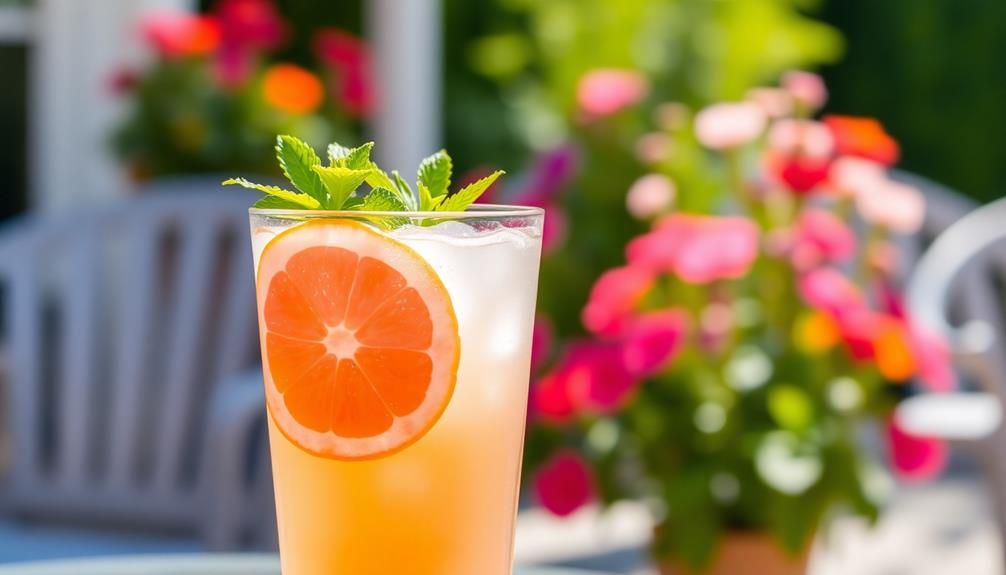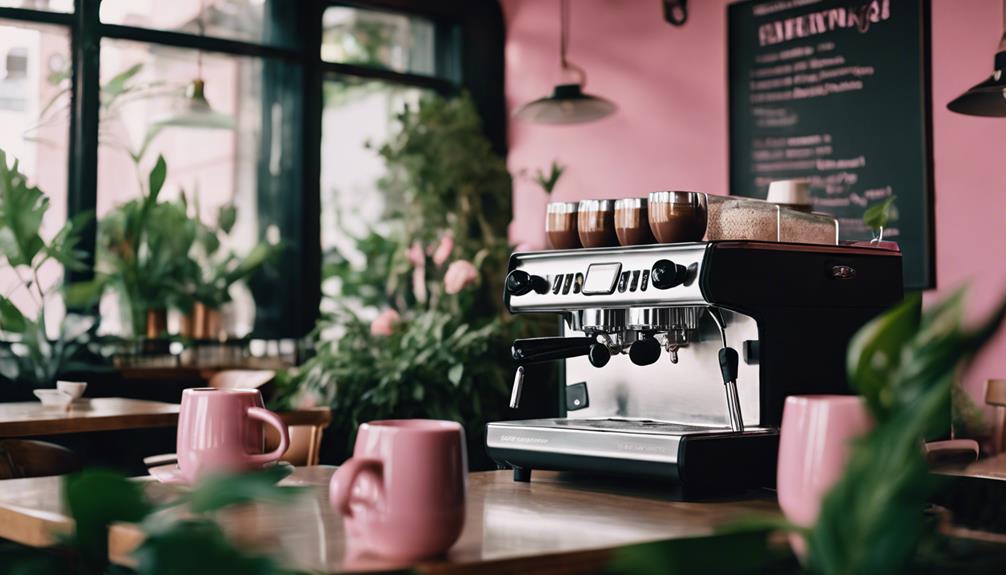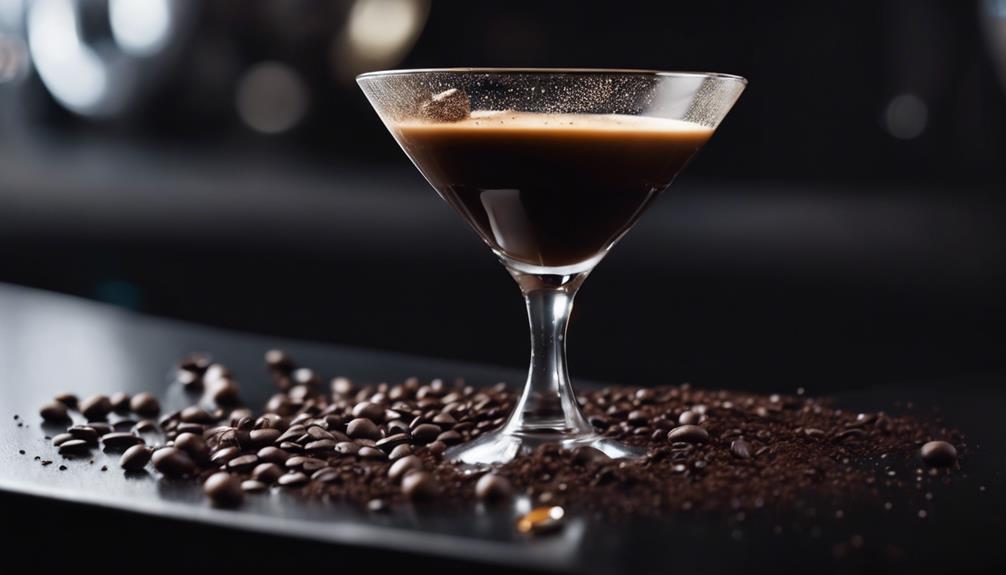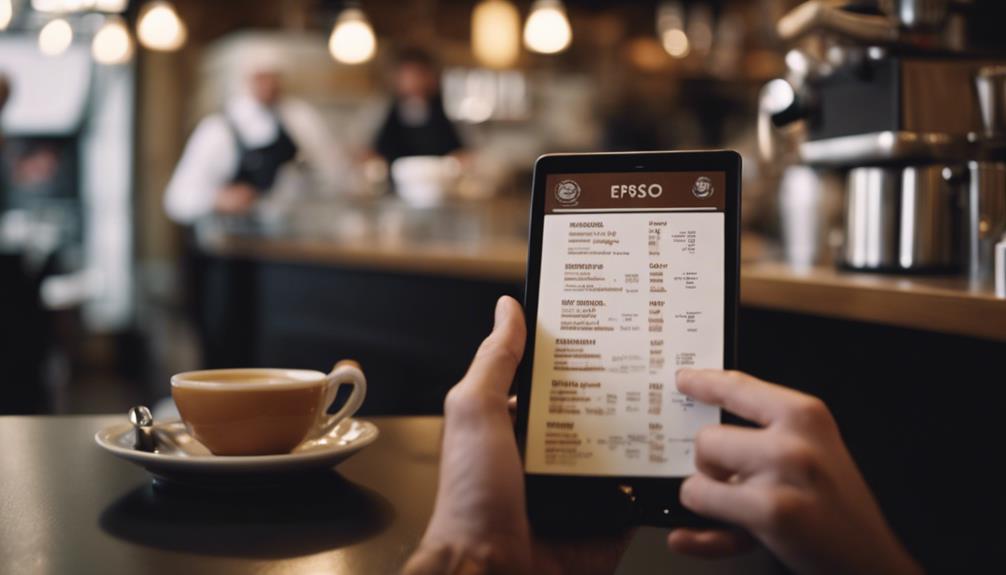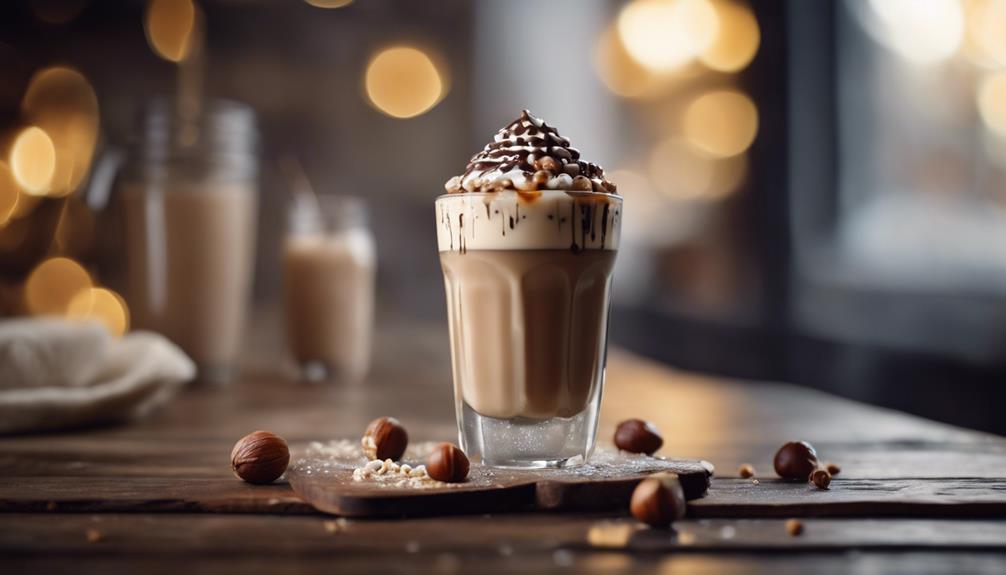Get ready to uncover the magic tricks to making the perfect shot of espresso by mastering dose, yield, and time. Shoot for a standard brew ratio of 1:1.5 to 1:2, using about 18 grams for a double shot. Fine-tune your brewing time to 25-30 seconds, and keep the water temperature between 188-205°F. By consistently measuring your dose and yield, you’ll achieve a well-rounded flavor profile. Once you nail down these crucial components, you’ll be on the path to brewing a shot that’s flavorful, full-bodied, and rich – and there’s a whole world of espresso exploration waiting for you to take it up a notch. So, get ready to elevate your espresso game!
Key Takeaways
- Use a consistent dose of 16-18 grams of coffee for a double shot, with a brew ratio of 1:1.5 to 1:2 for optimal flavor.
- Aim for a brewing time of 25-30 seconds, adjusting grind size to achieve the ideal flow rate of 1-1.5 grams per second.
- Ensure even coffee distribution and tamping with 30 lbs of pressure at a 90-degree angle to prevent channeling and under-extraction.
- Preheat the espresso machine, group head, and cups to achieve thermal stability, and flush the group head with water before brewing.
Essential Espresso Recipe Components
When crafting an espresso recipe, you'll need to focus on three key components: dose, yield, and time, as they work together to produce a perfectly balanced shot. These vital elements will help you achieve the perfect blend of flavors in your espresso. The dose refers to the amount of coffee used, while the yield is the amount of liquid espresso produced. The time, of course, is the duration of extraction.
A standard brew ratio for espresso is important, typically ranging from 1:1.5 to 1:2. This means for every gram of coffee used, you should aim to produce between 1.5 to 2 grams of liquid espresso. To guarantee peak extraction, aim for a brewing time of 25 to 30 seconds. This will help you achieve a balanced flavor profile in your espresso.
When it comes to dosing, consider common amounts like 18 grams for a double shot to maintain consistency and quality in your espresso preparation. By mastering these vital components, you'll be well on your way to brewing the perfect shot of espresso.
Understanding Dose and Yield Ratios
Now that you've got your essential espresso recipe components in place, it's time to fine-tune your dose and yield ratios.
You'll want to strike the perfect balance between the amount of coffee you use and the liquid espresso you produce, as this will greatly impact the flavor profile of your shot.
Dose Ratios Explained
Get familiar with the concept of dose ratios, as they play an essential role in perfecting your espresso shots. The dose refers to the amount of ground coffee used, ranging from 7-10g for a single shot to 20-22g for a triple shot. Yield, on the other hand, is the total weight of the espresso shot, aiming for a brew ratio between 1:1 to 1:3. Clive's signature recipe suggests a 1:1.5 ratio (20g coffee to 30g liquid espresso).
Here's a breakdown of the ideal dose and yield ratios for different espresso shots:
| Shot Type | Dose (g) | Yield (g) | Brew Ratio |
|---|---|---|---|
| Single | 7-10 | 14-20 | 1:1.4 to 1:2 |
| Double | 16-18 | 24-36 | 1:1.5 to 1:2 |
| Triple | 20-22 | 30-44 | 1:1.5 to 1:2 |
| Clive's Recipe | 20 | 30 | 1:1.5 |
Coffee to Liquid Balance
To perfect your espresso shots, you need to strike a delicate balance between the dose of ground coffee and the yield of liquid espresso, as this ratio greatly impacts the flavor profile of your brew.
The dose, or weight of ground coffee, typically ranges from 7-10g for a single shot, 16-18g for a double, and 20-22g for a triple shot.
The yield, or total weight of the espresso shot, usually ranges from 30g to 40g for a double shot, based on a common brew ratio of 1:2. However, Clive's signature recipe features a 1:1.5 brew ratio, using 20g of coffee to yield 30g of liquid espresso, vital for achieving a balanced flavor.
Adjusting the grind size can help you achieve the ideal extraction time of 25-30 seconds, which is essential for a perfect espresso shot.
Understanding the relationship between dose and yield ratios is key to optimizing espresso quality, as higher ratios produce stronger flavors while lower ratios yield milder profiles.
Optimizing Brewing Time and Technique
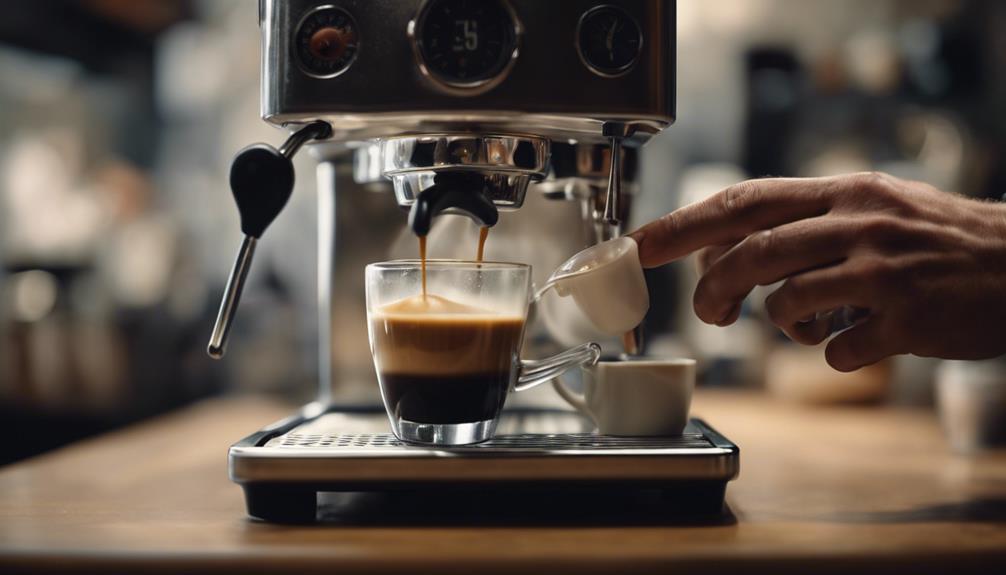
When you're perfecting your espresso recipe, you know that timing is everything.
You're about to learn how to optimize your brewing time and technique to extract the perfect shot.
Shot Timing Essentials
Mastering shot timing is essential in espresso brewing, as it directly impacts the flavor profile of your final product. Achieving the perfect shot time requires attention to detail and a clear understanding of the brewing process. Typically, the ideal shot time falls between 25 to 30 seconds, allowing for optimal extraction of flavors from the coffee grounds.
| Shot Time | Grind Size | Flavor Profile |
|---|---|---|
| < 25 seconds | Coarse | Under-extracted, sour |
| 25-30 seconds | Best | Balanced, optimal extraction |
| > 30 seconds | Fine | Over-extracted, bitter |
| Varies | Varies | Inconsistent brewing |
To fine-tune your shot timing, adjust your grind size accordingly. A coarser grind will accelerate extraction, while a finer grind will slow it down. Consistent brewing is key, so use a scale to measure both the yield and dose of coffee to achieve repeatable results. By monitoring your shot time and making adjustments as needed, you'll be well on your way to crafting the perfect espresso recipe.
Ideal Water Flow
Achieving ideal water flow is critical to enhancing brewing time and technique, as it directly impacts the flavor profile of your espresso shot. You want to aim for a flow rate of 1 to 1.5 grams of espresso per second during extraction, which will give you balanced and consistent results.
The key to achieving this is adjusting your grind size. A finer grind will slow down the water flow, while a coarser grind will speed it up, so you'll need to make adjustments based on your shot timing.
When you're tamping, make sure to maintain a level coffee bed to enhance water flow and prevent channeling, which can lead to uneven extraction. If your shots are pulling too quickly, you'll need a coarser grind, while shots that are pulling too slowly require a finer grind.
Consistent Grind Size
To optimize brewing time and technique, you need to maintain a consistent grind size, which is essential for ensuring uniform water flow through the coffee bed and preventing channeling. A consistent grind size, similar to confectionary sugar, allows for even pressure and prevents water from passing through the puck unevenly.
As you brew espresso, you'll find that fine adjustments to the grind setting may be necessary as coffee ages. A coarser grind can lead to faster extraction times, while a finer grind slows down the flow. If your shot is pulling too quickly, try a finer grind, and if it's pulling too slowly, try a coarser grind. The ideal shot time is between 25-30 seconds, and a consistent grind size helps you achieve this.
Perfecting Distribution and Tamping
You'll get the best out of your espresso by first leveling the coffee bed, an essential step that prevents channeling and guarantees even extraction. To achieve this, use a distribution tool or tap the portafilter to distribute the coffee grounds evenly and break up any clumps. This makes sure that the coffee is evenly saturated during brewing, resulting in a perfect shot of espresso.
| Distribution Technique | Tamping Pressure | Puck Preparation |
|---|---|---|
| Weiss Distribution Technique (WDT) | 30 lbs | Uniform puck for ideal extraction |
| Tap portafilter gently | Consistent pressure | Even distribution of coffee grounds |
| Use a distribution tool | 90-degree angle | Prevents channeling and clumping |
When tamping, apply consistent pressure, ideally around 30 lbs, at a 90-degree angle to create a uniform puck. Consistency in tamping pressure and technique is key, as variations can lead to significant differences in extraction quality. By mastering distribution and tamping, you'll be well on your way to brewing a perfect shot of espresso with even extraction and rich flavor. Remember, it's not about the force you apply, but rather the consistency and technique you use.
Mastering the Art of Shot Pulling
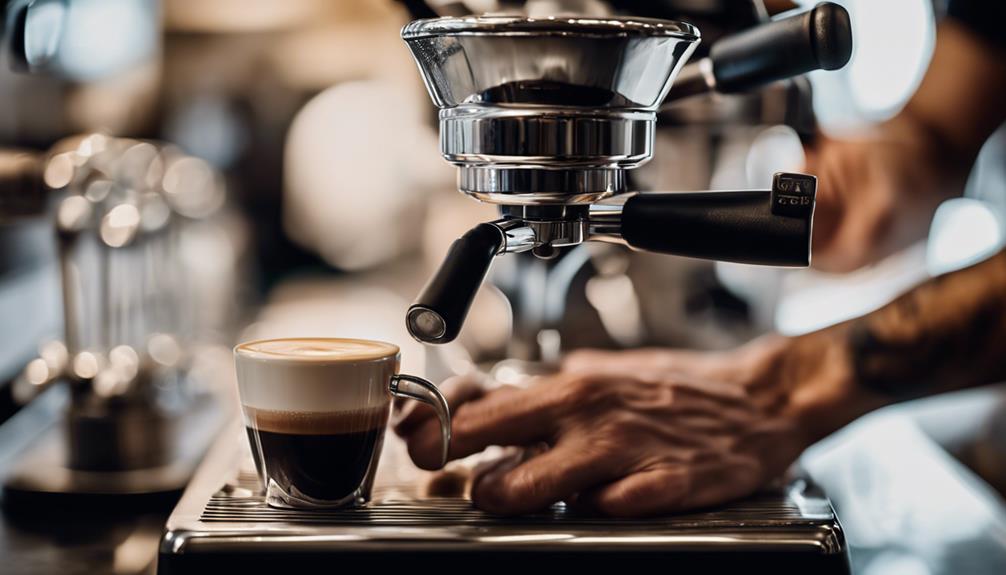
By the time you're ready to pull a shot, your espresso machine should be fully warmed up and clean, with water flushed through the group head to achieve ideal temperature.
Now, it's time to master the art of shot pulling. As you prepare to pull a shot, make certain you've got the right grind size to achieve the perfect extraction. Aim for a shot time of 25-30 seconds, adjusting the grind size accordingly if it pulls too quickly or slowly.
You're aiming for a double shot of espresso with a yield of 36-40 grams. Remember to maintain a consistent tamping technique, applying around 30 lbs of pressure to create a level coffee bed for even extraction.
As you pull the shot, observe the crema color and flow rate. A pale crema suggests under-extraction, while dark crema indicates over-extraction.
With practice, you'll develop a sense of what works best for your espresso brewing. By nailing these details, you'll be well on your way to pulling the perfect shot, complete with a rich crema on top.
Key Equipment and Preparation Tools
Now that you've mastered the art of shot pulling, it's time to focus on the essential tools of the trade.
You'll need a reliable espresso machine that can deliver consistent results, and a high-quality grinder that can produce a precise grind.
In this section, we'll explore the must-haves for your espresso setup, from machine essentials to grinder selection tips.
Espresso Machine Essentials
Equip yourself with the right gear, and you'll be well on your way to crafting exceptional espresso shots. A quality espresso machine is vital for achieving ideal extraction. For under $500, the Breville Infuser is a great beginner-friendly option.
| Equipment | Purpose | Recommendation |
|---|---|---|
| Espresso Machine | Achieve ideal extraction | Breville Infuser |
| Coffee Grinder | Fine and consistent grind size | Baratza Encore |
| Portafilter | Hold coffee grounds | Included with machine |
A burr coffee grinder is essential for fresh, high-quality coffee. The Baratza Encore is the best value grinder since 2015. You'll also need a scale to measure coffee doses accurately – a typical double shot requires 13-18 grams of coffee. Necessary tools include a tamper for compressing coffee grounds evenly into the portafilter and a distribution tool to prevent channeling during extraction. Don't forget to maintain a clean machine and regular equipment care to guarantee consistent espresso quality and prevent off-flavors from old coffee oils. With these essentials, you'll be well-equipped to brew the perfect shot!
Grinder Selection Guide
You'll want to invest in a high-quality grinder that can produce a fine, consistent grind size, as it's an essential factor in achieving ideal espresso extraction. A good espresso machine can only do so much if the coffee grinders aren't up to par.
Look for grinders with flat burrs of at least 55mm and stepless grind settings to allow for precise adjustments based on the coffee's age and characteristics. If you're just starting out, manual grinders like the 1Zpresso J-Max provide excellent control and value.
Remember to regularly clean and maintain your grinder to prevent stale coffee oils from affecting the flavor and quality of your espresso shots.
When it comes to measuring coffee doses, invest in a scale to verify you're using the best 16-18 grams of coffee for a double shot.
With a good grinder and the right amount of coffee, you'll be well on your way to brewing good espresso. It just takes practice and patience to get the grind just right. Ground correctly, your coffee will be clean and dry, and you'll be enjoying perfect shots in no time.
Crucial Factors for Brewing Success
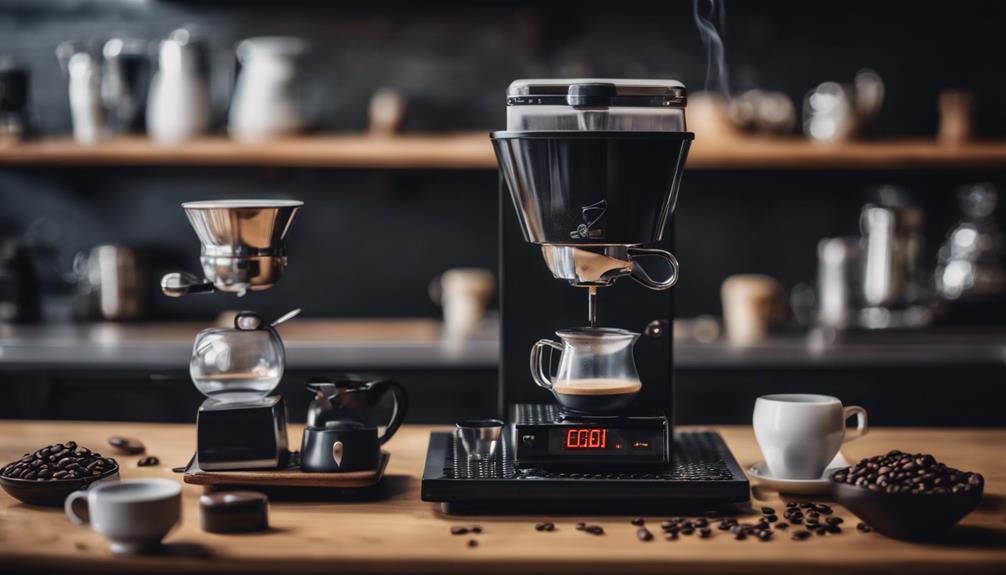
Frequently, a perfect shot of espresso hinges on attention to a few essential factors that can make all the difference between a mediocre brew and a sublime one.
To brew the perfect shot, you'll want to focus on getting the grind size just right – think confectionary sugar. This fine grind guarantees peak extraction and flavor transfer during brewing.
Next, maintain a consistent tamping pressure of around 30 lbs to prevent under-extraction or over-extraction, which can affect the flavor profile of your shot.
You'll also want to monitor the shot time, aiming for 25-30 seconds to achieve a balanced and flavorful espresso.
The brew ratio is another vital factor, with a common range of 1:1.5 to 1:2, allowing you to adjust based on personal taste preferences.
Finally, regularly check and maintain the water temperature between 188-205°F, depending on the roast type, to maximize extraction and enhance the overall flavor of your espresso.
Espresso Puck Preparation Techniques
As you prepare the espresso puck, measuring and grinding 18 grams of coffee to a fine consistency, similar to confectionary sugar, is vital for ideal extraction during brewing. This guarantees you're working with the perfect amount of coffee for peak extraction.
Next, use a distribution tool or gently tap the portafilter to evenly distribute the coffee grounds in the basket. This prevents channeling and promotes uniform extraction.
Before brewing, flush the group head with water to guarantee cleanliness and peak brewing temperature, essential for achieving the best flavor extraction.
Consider using the Weiss Distribution Technique (WDT) to break up clumps in the coffee grounds, guaranteeing even distribution and enhancing the flow of water through the puck during extraction.
Tamping Process and Techniques Explained
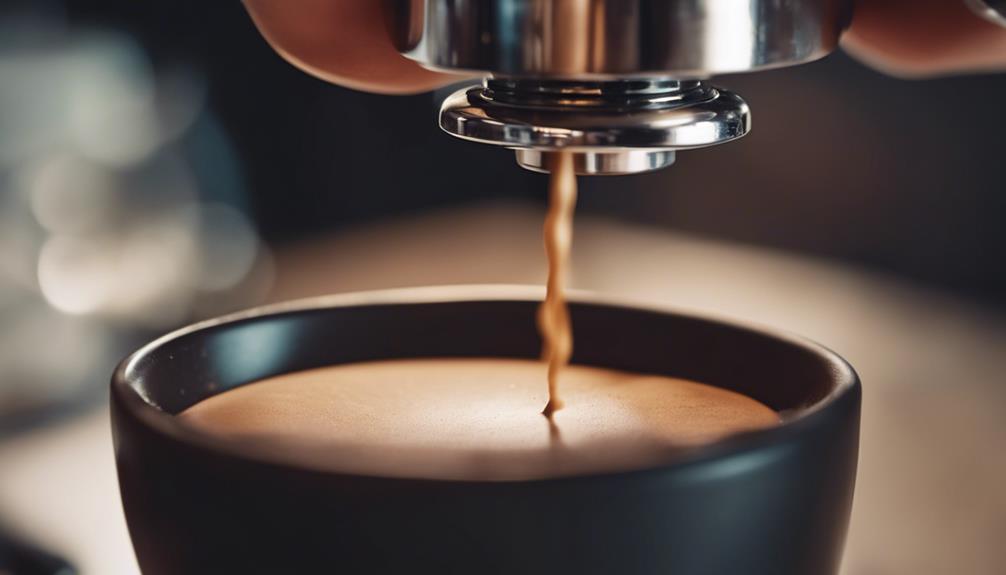
By mastering the tamping process, you're guaranteeing that the coffee grounds are evenly compressed, which is essential for achieving ideal extraction and preventing channeling during brewing.
To achieve this, you need to apply consistent tamping pressure of around 30 lbs. Anything more doesn't improve the flavor, and under-tamping can lead to under-extraction.
Before tamping, make sure you've distributed the coffee grounds evenly in the portafilter to create a level coffee bed. This prevents channeling and guarantees even extraction.
Hold the tamper at a 90-degree angle, gripping it like a doorknob, and apply gentle, consistent pressure throughout the process.
Consider using a distribution tool or the Weiss Distribution Technique (WDT) to eliminate clumps and promote uniformity in the coffee puck.
Remember, practice is key to mastering tamping techniques. Developing a steady hand and repeatable motions will lead to more consistent espresso shots over time.
With consistent tamping, you'll be well on your way to brewing perfect espresso shots.
Brewing and Serving the Perfect Espresso
With your coffee grounds expertly tamped, you're ready to brew the perfect espresso shot, aiming for a total yield of 36-40 grams with a brew time of 25-30 seconds. To achieve this, guarantee your coffee dose is around 18 grams for a double shot, utilizing a brew ratio of 1:2 to balance strength and flavor.
Here's a quick reference guide to help you brew the perfect espresso:
| Variable | Ideal Range | Impact on Flavor |
|---|---|---|
| Brew Time | 25-30 seconds | Balances acidity and body |
| Coffee Dose | 18 grams | Affects strength and flavor |
| Crema Color | Light brown to reddish | Indicates ideal extraction |
| Thermal Stability | Preheat cups and group head | Guarantees consistent extraction |
| Brewing Variables | Document and refine | Maintains flavor quality |
Frequently Asked Questions
How to Make a Perfect Shot of Espresso?
To make a perfect shot of espresso, you'll need to focus on precise measurements, grinding, and tamping. You're aiming for a smooth, balanced flavor, so don't skip the details – it's worth the extra effort!
How to Perfectly Brew Espresso?
You're on a quest to perfectly brew espresso! To achieve this, you'll need to nail the coffee-to-water ratio, grind size, and tamping pressure, then monitor the shot's flow and crema color to guarantee ideal extraction.
What Are the 4 Qualities of a Perfect Espresso Shot?
You're looking for the perfect espresso shot, and it's all about four key qualities: a rich, golden crema; a balanced flavor profile; a smooth, consistent flow; and an inviting aroma that complements the taste.
What Is the Best Ratio for Espresso Shots?
"A million ratios to choose from, but which one's the magic number for you? The best ratio for espresso shots is subjective, but generally, a 1:1 to 1:3 range is ideal, with 1:2 being a popular starting point for a balanced flavor."
Conclusion
You've reached the crescendo of espresso mastery! With each shot, you're now a conductor, harmonizing dose and yield, brewing time and technique, distribution and tamping.
The puck's preparation is a waltz, the tamping process a gentle press. As you brew and serve, the aromas swirl, a symphony of flavors.
Your perfect shot is a work of art, a masterpiece born from precision and practice. Savor the silence, for in this moment, you're the maestro of espresso.

